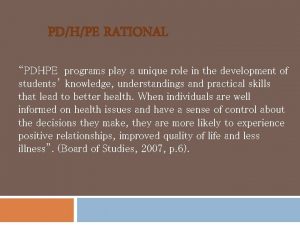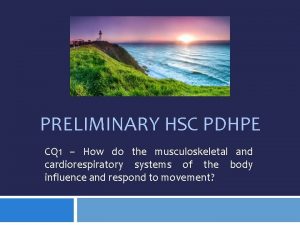HSC PDHPE CQ 4 DP 1 CQ 4
































- Slides: 32

HSC PDHPE – CQ 4 DP 1 CQ 4 – What actions are needed to address Australia’s health priorities?

What actions are needed to address Australia’s health priorities? Students learn about: Students learn to: • q q health promotion based on the five action areas of the Ottawa Charter levels of responsibility for health promotion the benefits of partnerships in health promotion, eg government sector, nongovernment agencies and the local community how health promotion based on the Ottawa Charter promotes social justice the Ottawa Charter in action • q q • • argue the benefits of health promotion based on: individuals, communities and governments working in partnership the five action areas of the Ottawa Charter investigate the principles of social justice and the responsibilities of individuals, communities and governments under the action areas of the Ottawa Charter critically analyse the importance of the five action areas of the Ottawa Charter through a study of TWO health promotion initiatives related to Australia’s health priorities

1. health promotion based on the five action areas of the Ottawa Charter Over the last 20 years there has been a rapid growth in the way health issues are addressed through health promotion. Health promotion is a comprehensive social and political process, not only including actions directed at strengthening the skills and capabilities of individuals, but also action directed towards changing social, environmental and economic conditions so as to lessen their impact on public and individual health. Effective health promotion requires multiple approaches involving many individuals and organisations. Political, economic, social, environmental and behavioural factors all interact in establishing a climate that is fully supportive of individual and community well-being.

Ø levels of responsibility for health promotion Health is everybody’s business and therefore everyone is responsible for promoting health. Health promotion is not just the responsibility of the health sector but requires a coordinated action by all governments as well as by health and other social and economic sectors, non-government and voluntary organisations, local authorities, industry and the media. Every person can take on the responsibility to promote health, whether as an individual or as a member of a family or community. Professional and social groups and health personnel have a major responsibility to mediate between differing interests in society for the pursuit of health.

The Ottawa Charter ü ü ü The Ottawa Charter was developed in 1986 to build a global ‘all for health’ movement as a means to realise the right to health of all humans. The five action areas of the Ottawa Charter are: developing personal skills creating supportive environments strengthening community action reorientating health services building healthy public policy The charter aims to develop partnerships and support networks with public, private, government, nongovernment and international organisations to create and maintain actions to promote health.

levels of responsibility for health promotion At the national level, the job of government and organisations is to create an environment for improving health. This is done by providing coordination and leadership; encouraging federal, state and territorial collaboration; providing the public and other stakeholders with the information and resources they need; working together with international bodies to share information; and developing the infrastructure to establish and support a social health approach.

levels of responsibility for health promotion At the state and territorial level, the responsibility of government and organisations is to work together to develop healthy public policies, balance investments and regularly provide health information to members of the public. They are also responsible for developing health goals and effective frameworks or structures that reflect the population health approach. Population health is an approach to health that aims to improve the health of the entire population and to reduce health inequities among population groups.

levels of responsibility for health promotion The responsibility of the private sector in promoting health is to ensure that it provides a safe and healthy working environment that has opportunities for continuous learning. In promoting health, the private sector must also take into account its responsibility for protecting the environment and contributing to the overall well-being of the community.

levels of responsibility for health promotion At the community level, communities with a common interest or concern can focus their energies on developing partnerships that address the determinants of health. For example, the government may provide funding to health related organisations, such as the Heart Foundation or Cancer Council, to support research; plan and provide high quality services that promote health; share information and resources designed to have optimum health impacts; and involve the individuals who have a vested interest in setting priorities and implementing programs.

levels of responsibility for health promotion As individuals, we can all contribute by taking responsibility for our own health and well-being; actively seeking out the information we need to make informed health decisions; building supportive communities; and participating in community activities that have an impact on health. For example, schools have a ‘no hat no play’ policy to protect students from the sun.

levels of responsibility for health promotion ü ü ü Within the above levels, there may be partners at different levels. Depending on the context and the nature of the intersectoral action, levels may be defined in different ways; for example, in terms of: geography (such as local/community, regional, state, national and international levels) levels of government (that is, local, state/territorial and federal) levels within organisations (such as senior decision making level and service-delivery level).

As the broad list of examples in Table 4. 1 (in the following slide) shows, effective health promotion must involve the cooperation of a variety of government and non-government organisations. The public health approach acknowledges that effective health promotion requires intersectoral involvement. It also emphasises the importance of creating an environment that is fully supportive of positive health behaviours and actively involves the community.


Ø Task/activity Choose five of the health promotion initiatives listed in Table 4. 1. (previous slide) Identify the levels of responsibility involved for each initiative

Ø the benefits of partnerships in health promotion, eg government sector, non-government agencies and the local community The key aspect of health promotion is understanding that improving health is a shared responsibility. Intersectoral collaboration is the teamwork among health and other groups to improve health outcomes. Health groups and those groups not normally associated with health, but whose activities may have an impact on health or the factors known to influence it, share the responsibility and accountability for health outcomes.

Ø the benefits of partnerships in health promotion, eg government sector, non-government agencies and the local community Successful initiatives developed by different sectors are, by their nature, challenging to achieve. Intersectoral action about a health concern makes possible the joining of all the knowledge available about the health concern. It also allows for access to the resources and skills needed to understand solve complex issues where possible solutions lie outside the capacity and responsibility of a single sector.

the benefits of partnerships in health promotion, eg government sector, non-government agencies and the local community oral action can be used to promote and achieve shared goals in a number of areas; for example policy, research, planning, practice and funding. It may be implemented through numerous activities, including advocacy, legislation, community projects, policy and programs. Intersectoral action may take many forms, such as passing of legislation. It is most successful when characterised by a dynamic and flexible process that is perceived as a ‘win-win’ situation by all participants.

the benefits of partnerships in health promotion, eg government sector, non-government agencies and the local community Intersectoral action requires the development of a strategic plan. This is a clear outline of the steps taken to achieve the goals and intended outcomes of the initiative. For example, the strategic plan outlines a timeline as well as the key people or organisations involved, the budget requirements and an evaluation of the results. A relationship between one or more parts of the health sector and one or more parts of another sector is important.

the benefits of partnerships in health promotion, eg government sector, non-government agencies and the local community This will help to ensure the action taken to address an issue and achieve health outcomes is a more effective, efficient and sustainable approach than is possible when the health sector works alone. There is no doubt that intersectoral action for health has worked. There are many success stories at international, national and local levels. For example, publicly funded immunisation programs that involve the health, education and, in some cases, social services systems have been successful in reducing the incidence and prevalence of communicable diseases and their complications.

the benefits of partnerships in health promotion, eg government sector, non-government agencies and the local community Healthy communities projects all across Australia have brought about changes that have resolved health problems and greatly improved the quality of life of people. The National Mental Health Strategy brought together federal government departments with state and territorial governments, community groups, professional associations and private sector organisations to develop an intersectoral response to addressing mental health issues. Intersectoral action results in increased public awareness; implementation of a range of health, social service, criminal justice and housing services; and networks of partners who continue to work together.

the benefits of partnerships in health promotion, eg government sector, non-government agencies and the local community ü ü There are significant potential benefits to be realised from adopting, supporting and sustaining an intersectoral action approach, including: a greater capacity to tackle and resolve complex health and social problems that have eluded individual sectors for decades, resulting in improved population health and well-being, and reduced demand for health care and social services in future a pooling of resources, knowledge and expertise, and development of networks, that will allow partners to address current problems more effectively and position them to respond better to future issues reductions in duplication of effort among different partners and sectors new collaborative and inclusive ways of working together that will enable partners to contribute to improvements in social cohesion, provide increased opportunities for sustainable human development, and create a more dynamic and vibrant society.

Ø Questions to complete 1 The public health approach requires the cooperation of government and community. Explain, with the use of examples, how this cooperation can take place. 2 Smoking is a major health concern in Australia. Conduct a review of health promotion strategies designed to reduce smoking. Argue the benefits that partnerships have had on health promotion in relation to smoking. 3 Complete the task for other major risk factors related to the national health priorities; for example, nutrition and physical activity.

Ø how health promotion based on the Ottawa Charter promotes social justice The Ottawa Charter promotes social justice as it is designed to provide access to health opportunities for all members of society. This requires policy approaches, planning decisions and strategies to enhance access to those factors and situations that support health. Resources need to be allocated appropriately, taking into account that some need more than others. It is important that all individuals or groups be accounted for in the decision-making processes, as this allows the decisions to be made within a social justice framework.

Social justice involves treating all people equally and providing people with equal rights. Basically, it is about giving everyone a ‘fair go’. Since inequality still exists in society, treating everyone the same does not necessarily mean fairness of treatment. Social justice targets the marginalised groups of people in society—it focuses on the disadvantaged. Social justice recognises that there are situations where applying the same rules to unequal groups can generate unequal results. Social justice provides equitable outcomes to marginalised groups by recognising the existence of past disadvantage and that structural barriers embedded in the social, economic and political system perpetuate systemic discrimination. In promoting health, equity underpins practice. A socially just society is much more likely to be a healthy society— physically, economically, spiritually, emotionally and environmentally.

According to a 1986 report by WHO, the Ottawa Charter refers to health promotion as the ‘process of enabling people to increase control over, and to improve, their health’. The Fourth International Conference on Health Promotion held in Jakarta in 1997 provided an opportunity to reflect on what had been learned about effective health promotion, to reexamine the determinants of health, and to identify the directions and strategies that must be adopted to address the challenges of promoting health in the twenty first century.

The Jakarta Declaration presents actions for health promotion that need to occur in the twenty-first century. According to a 1997 report by WHO, it reinforces the importance of collaborative partnerships in effective health promotion; that is, where organisations work together to achieve common goals. The Jakarta Declaration also highlights the need to ‘increase community capacity and empower the individual’.

Those groups who do not have power, or feel powerless, experience worse health. However power might be measured, those with more power are healthier. When individuals are given the opportunity to participate in the political, cultural or social process they are able to state their needs accurately. They are in a position to contribute actively to the development of strategies designed to assist them. Rather than merely be the recipient of the health promotion outcome, they become a part of the process. Individuals are empowered when their decisionmaking abilities are improved and this gives them more control over their lives.

The empowerment of individuals is fundamental to the public health approach. When individuals are empowered, social justice is achieved. People are enabled to make changes in the context of their lives that enhance their health. Health workers can be advocates to influence policy at all levels through formal lines of authority. Health promotion work involves advocating on behalf of vulnerable community groups for the desired changes to be enshrined in policy. Policy within government can also be used to bring about change in the social environment, management systems and structures, and to provide the rationale for action in support of the community. In a similar fashion to individual empowerment, communities are given the opportunity to express their needs and to be an active part of the health promotion process. The public health approach develops structures and policies to support communities in achieving their goals.

According to a 1986 WHO report, as the Ottawa Charter for Health Promotion stated: ‘At the heart of this process is the empowerment of communities, their ownership and control of their own endeavours and destinies’. The Ottawa Charter identified the ‘strengthening of community action’ as a fundamental principle of health promotion. The emphasis of the public health approach is on working with communities. This approach supports strategies that are developed by communities, not those strategies that are imposed on them. In this way, communities feel a sense of ownership and confidence. As a result, the chances of successful interventions significantly increase. It is important to note that communities are not necessarily defined by geographic barriers. Communities may be characterised by other factors, such as race, socioeconomic status or profession. The scenarios opposite are common examples of situations that occur in our society. By applying the actions of the Ottawa Charter we can promote social justice and promote health.

Ø the Ottawa Charter in action ü ü ü The five action areas of the Ottawa Charter reflect the ‘public health approach’, with a special emphasis on social justice issues. The six priority issues for investigation are: cardiovascular disease cancer diabetes respiratory disease injury mental health problems and illnesses


 Hsc pdhpe
Hsc pdhpe Risk behaviours definition pdhpe
Risk behaviours definition pdhpe Continuous training pdhpe
Continuous training pdhpe Temperature regulation pdhpe
Temperature regulation pdhpe What is aerobic training pdhpe
What is aerobic training pdhpe Hydrotherapy
Hydrotherapy Physiological adaptations pdhpe
Physiological adaptations pdhpe Graduated exercise pdhpe
Graduated exercise pdhpe Kinaesthetic sense pdhpe
Kinaesthetic sense pdhpe Pdhpe core 1 practice questions
Pdhpe core 1 practice questions Centre of gravity pdhpe
Centre of gravity pdhpe Crisis management pdhpe
Crisis management pdhpe What is totaps
What is totaps Ottawa charter pdhpe
Ottawa charter pdhpe Fluid mechanics pdhpe
Fluid mechanics pdhpe 2015 hospitality hsc exam
2015 hospitality hsc exam Religion and peace essay hsc
Religion and peace essay hsc Hsc all my own work
Hsc all my own work Hsc hub
Hsc hub Declining balance method formula hsc
Declining balance method formula hsc Hsc alarm matrix
Hsc alarm matrix Hsc multiple choice
Hsc multiple choice Investigating science hsc
Investigating science hsc Yonas ogbamicael
Yonas ogbamicael Wilfred owen poems hsc
Wilfred owen poems hsc Hsc subject selection
Hsc subject selection Minimum standards practice test
Minimum standards practice test Hsc pension calculator
Hsc pension calculator Percentage error hsc
Percentage error hsc Hsc science extension
Hsc science extension Hsc 3047
Hsc 3047 My pension hscni
My pension hscni Gap filling without clues for ssc
Gap filling without clues for ssc












































